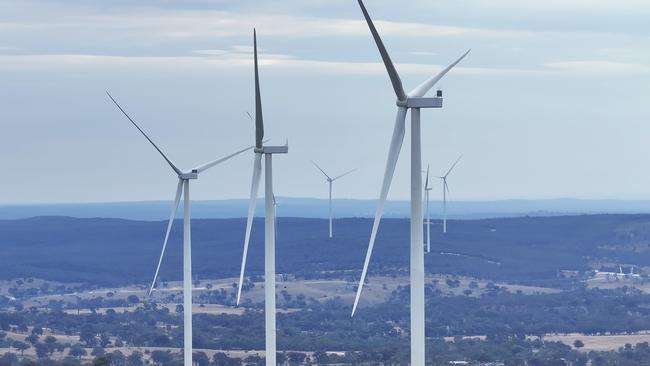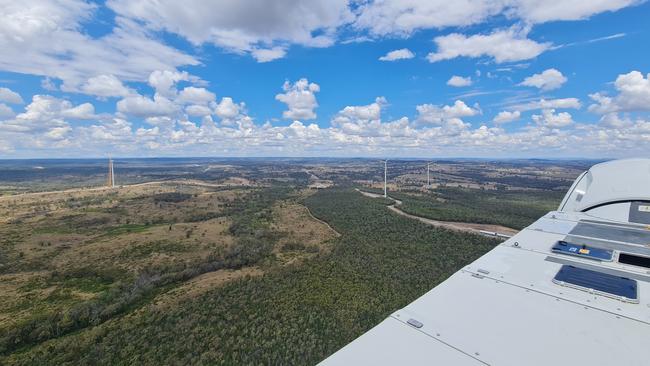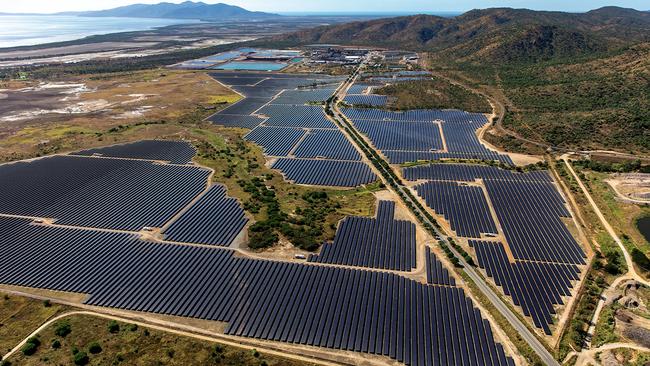Acciona flicks switch on MacIntyre wind farm, but warns of environmental roadblocks
Acciona has flicked the switch on the biggest wind farm in the southern hemisphere, but warns environmental rules remain the major obstacle for more renewables.

Business
Don't miss out on the headlines from Business. Followed categories will be added to My News.
Stringent environmental approvals remain the biggest obstacle to the rollout of major wind and solar farm developments, according to Acciona Energia’s boss in Australia, amid fears the nation is slipping further behind the federal government’s 2030 renewables targets.
Speaking to The Australian as the Spanish renewables giant flicks the switch on the mammoth MacIntyre wind farm in Queensland, managing director Brett Wickham said conditions tied to federal approvals often drove the wrong environmental outcomes, and called for a more flexible approach tailored to issues facing local regions.
“If I hark back to four or five years ago, the grid connection process was probably the longest, most critical part of building a project,” he said.
“But EPBC (Environment Protection and Biodiversity Conservation Act) is something now which is certainly taking us longer than we would have expected. EPBC, at the moment, is probably the biggest challenge we’re seeing on lots of projects.
“We’ve got to make sure we’re driving the right environmental outcomes. EPBC has got to evolve as the industry evolves.”

In the case of the 926MW MacIntyre project – which has become the largest operating wind farm in the southern hemisphere after generating its first power for the national electricity grid – Mr Wickham said Acciona was required to set aside close to 3500ha of land for the establishment of vegetation offsets.
“That’s fine, but if you do that for every project across Queensland, it can cause you significant issues with respect to locking up land which otherwise should be good agricultural land,” he said.
“We don’t shy away from the fact that we have to be considerate and be obliged and bound to the EPBC Act and its requirements, but I think sometimes you can get better EPBC outcomes than just locking up large pieces of land.
“It might be remediating areas of significant erosion, or it could be looking at very sensitive environmental issues that are in the region or the area that we are in – you may get better environmental outcomes by addressing those very specific issues in the regions.
“We’ve been very closely working with the department (Environment) to look at how we can create better outcomes in the EPBC space.”
The MacIntyre wind farm, around 200km southwest of Brisbane, will generate its first power on Friday, with the first 27 turbines connected to the grid and supplying the National Electricity Market.

The wind farm – a joint venture between Acciona and Korea Zinc subsidiary Ark Energy – will eventually include 162 turbines, almost doubling the total amount of wind energy generated in Queensland when fully operational in the third quarter of 2025.
Stretching across 36,000ha with 12 host landowners, it will generate enough renewable energy to power more than 600,000 homes.
Mr Wickham described first generation as a “momentous” milestone for the project, which would go some way to supporting the government’s goal of having renewables generate 82 per cent of the country’s power by 2030.
While conceding it would a “challenge” reaching that target, he said the MacIntyre project showed renewables could be successfully built at scale in Australia, and urged industry and governments to work together to accelerate the energy transition.
“The grid process seems to be a lot clearer and a lot easier to navigate now than it was, say, five or six years ago,” he said.
“We’ve had really good success on working at the state government level and also the local government level on these projects.
“I think it’s going to be tough, but I don’t think we should be taking the foot off the accelerator.
“We have to push as hard as we possibly can – if we don’t achieve the full target, but get very close, we’ve got to die trying to achieve those targets.”
The MacIntyre wind farm is part of the greater MacIntyre Wind Precinct, comprising the MacIntyre wind farm and the proposed Herries Range wind farm.
When complete, around 2GW of renewable energy will be generated from the precinct – enough to power the equivalent of more than a million homes.

Ark Energy will use some of the electricity generated from its share in the MacIntyre wind farm to support decarbonisation plans for sister company Sun Metals Corporation’s Townsville zinc refinery.
Sun Metals aims to be the world’s first producer of green zinc, and has committed to powering its operations from 100 per cent renewable sources by 2040.
The MacIntyre wind farm also has PPAs (power purchase agreements) with Queensland government-owned enterprises Stanwell Corporation and CleanCo totalling 550MW.
While developers have warned a dwindling number of wind projects means Australia has little chance of reaching its renewable energy targets, Mr Wickham said the nation’s stable political, economic and regulatory environment made it an attractive destination for international investors, particularly in light of geopolitical issues facing many other regions.
“When you look at it from a risk-weighted perspective, Australia will always be a destination,” he said. “Our chairman’s made it very clear that we will continue to invest in Australia, and we have people approaching us all the time to invest in our projects. The comments about nuclear sometimes caused a bit of a disruption in the force. That’s the thing that worries me the most, that you can actually scare investors off by that.
“What they want is to make decisions to bring large amounts of equity, and debt in some cases, to this country, and they just want to know that they’ll have their stable return over a long period of time – these are projects that have a 30, 40 or 50 year life.”
More Coverage
Originally published as Acciona flicks switch on MacIntyre wind farm, but warns of environmental roadblocks




